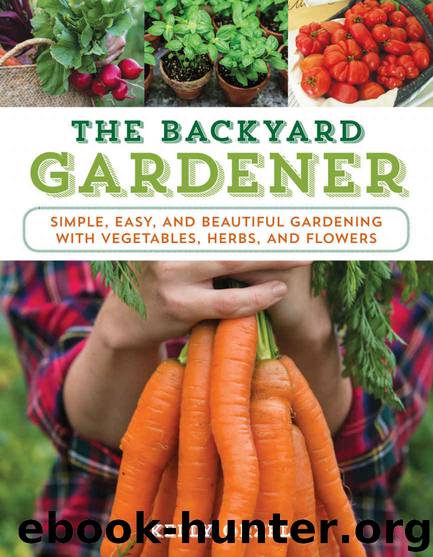The Backyard Gardener: Simple, Easy, and Beautiful Gardening with Vegetables, Herbs, and Flowers by Kelly Orzel

Author:Kelly Orzel [Orzel, Kelly]
Language: eng
Format: azw3, epub
ISBN: 9781493026586
Publisher: Lyons Press
Published: 2017-04-01T04:00:00+00:00
Potatoes (Solanum tuberosum)
Family: Solanaceae
Plant Type: Annual, zone 3–11
Light: Full sun
Soil: Loose, well-drained
Height × Width: 24–30ʺ × 24ʺ
pH: 5.0–6.5
Sow: 2–4ʺ deep, 2 weeks before last frost
Succession: Early-, mid-, and late-season varieties
Days to germination: n/a
Days to maturity: 90–110 days (early), 100–120 days (mid), 110–140 days (late)
Water: Moist, not waterlogged Feed: High, avoid high nitrogen
Friends: Beans, brassicas, corn, eggplant, and marigolds
Foes: Cucumber, fennel, kohlrabi, pumpkin, squash, sunflower, and turnip
In the mood for a treasure hunt? Try growing potatoes, one of the most productive—and easiest—crops to grow. While you can start them from seed, it’s significantly quicker to use seed potatoes. Catalogs offer an expanded selection of seed spuds. From the thumb-sized, skinny fingerlings to medium and large, rounded potatoes available with blue, purple, red, white, and yellow skins and flesh, you’ll be surprised at the wide array of choices of shapes and colors. Use the whole seed potato or cut into smaller pieces—but they have to have at least two eyes, or sprouts, and enough flesh to feed the growing potato until the root system has developed. Some gardeners say they should weigh two ounces, but as I don’t often have a scale handy, I just make sure that none of my cut seed potatoes are smaller than one-and-one-half to two inches. To avoid rot and disease, allow cut potatoes to “heal” in the sun or in a cool, dry spot before planting unless the soil is warm, then plant away! If your spuds haven’t grown eyes yet, they need to be chitted. Simply lay them out indoors on a bright windowsill and leave them for a week at room temperature till the sprouts are one inch long. Sometimes I set them in an old egg carton until they sprout. Don’t let the shoots get too leggy, and be careful not to damage them when planting.
Download
The Backyard Gardener: Simple, Easy, and Beautiful Gardening with Vegetables, Herbs, and Flowers by Kelly Orzel.epub
This site does not store any files on its server. We only index and link to content provided by other sites. Please contact the content providers to delete copyright contents if any and email us, we'll remove relevant links or contents immediately.
Turbulence by E. J. Noyes(7942)
The Thirst by Nesbo Jo(6832)
Gerald's Game by Stephen King(4584)
Be in a Treehouse by Pete Nelson(3953)
Marijuana Grower's Handbook by Ed Rosenthal(3623)
The Sprouting Book by Ann Wigmore(3544)
The Red Files by Lee Winter(3368)
The Remains of the Day by Kazuo Ishiguro(3295)
Sharp Objects: A Novel by Gillian Flynn(2958)
Christian (The Protectors Book 1) by L. Ann Marie(2655)
Organic Mushroom Farming and Mycoremediation by Tradd Cotter(2631)
The Culinary Herbal by Susan Belsinger(2433)
Stone Building by Kevin Gardner(2353)
The Starter Garden Handbook by Alice Mary Alvrez(2285)
Lilac Girls by Martha Hall Kelly(2258)
The Unlikely Pilgrimage of Harold Fry by Rachel Joyce(2221)
The Lean Farm Guide to Growing Vegetables: More In-Depth Lean Techniques for Efficient Organic Production by Ben Hartman(2099)
Urban Farming by Thomas Fox(2062)
Backyard Woodland by Josh VanBrakle(1895)
